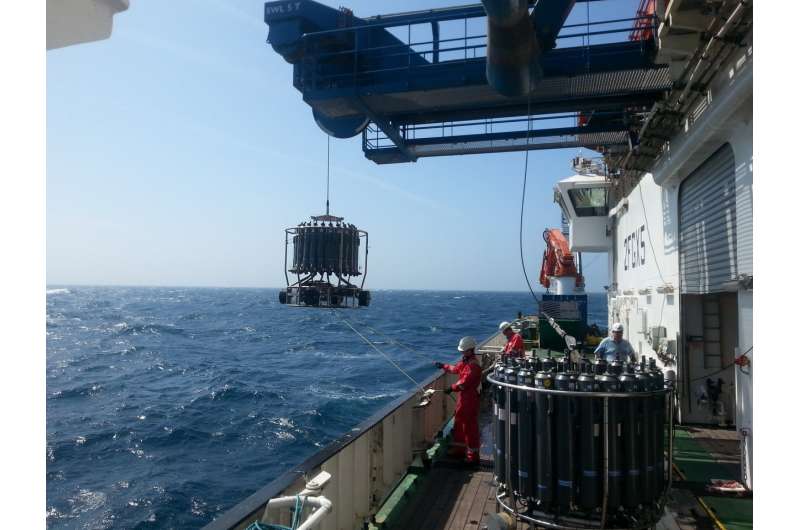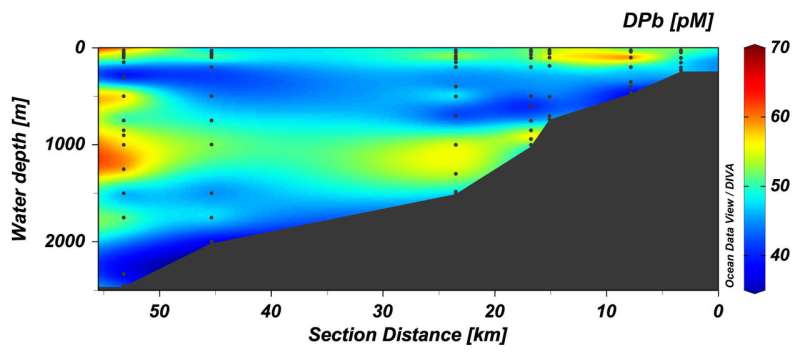Anthropogenic lead still present in European shelf seas

Over many decades, human activities have release lead into the atmosphere, including combustion of leaded fuel. A group of researchers led by GEOMAR, Kiel, have now demonstrated that after the phase-out of leaded gasoline in Europe in recent decades, there has been a four-fold reduction in lead concentrations in the European shelf seas. Nevertheless, the legacy of the historical global lead pollution is still evident.
Lead (PB) is one of few elements for which the impact of human activity on the marine environment is clearly evident. It has no biological function and is toxic to humans and marine organisms. The anthropogenic perturbation dates back to the middle of the 19th century, with coal and leaded gasoline combustion serving as major lead sources to the atmosphere. Anthropogenic lead is transported in the atmosphere over long distances and deposited in remote areas resulting in enhanced lead concentrations in surface oceans of >190 pmol kg-1 during the peak of the lead emissions in 1970-1980. These are about 100 times higher than natural background levels.
Since then, stricter environmental regulations have resulted in reduced lead emissions into the environment. Leaded gasoline has now been virtually phased out with notable decreases in lead concentrations in oceanic surface waters. A study by an international team of scientists led by GEOMAR Helmholtz Centre for Ocean Research Kiel presents new observational data that indicates a reduction in lead concentrations in surface waters of European shelf seas. Nevertheless, the legacy of lead, in particular from the Mediterranean, is still present, and new lead sources emerge in the marine environment. The team has published its results in the renowned international scientific journal Geophysical Research Letters.
The last assessment of lead concentrations in European shelf seas was undertaken when leaded gasoline was still widely used. In the new study the marine biogeochemists Dagmara Rusiecka, Dr. Martha Gledhill and Professor Eric Achterberg from GEOMAR showed that a four-fold reduction in lead concentrations is evident in surface waters of the Celtic Sea, compared to measurements undertaken two to three decades ago.
"This is the first study showing a pronounced reduction in lead concentrations in European surface waters since the phasing out of leaded gasoline," says Dagmara Rusiecka, Ph.D. student and lead author of this study, "and underpins that the successful phasing out of leaded gasoline led to a substantial reduction in atmospheric lead pollution and deposition in marine waters."
Nevertheless, in the study area, the lead concentrations are still 10 to 60-fold higher than natural background levels. The lead deposited in the ocean is ultimately transferred to the sediments. "Since the atmospheric inputs are reduced, we can now see that the legacy lead is being released by the sediments, forming a new lead source to the environment," says Prof. Eric Achterberg from GEOMAR. Interestingly, waters from the Mediterranean that reach European shores at a depth of about 1000 meters carry a strong anthropogenic lead signal. The Mediterranean has received a great deal of lead from surrounding countries such as Italy, Spain and Greece, which only phased out leaded gasoline in 2003.

The results are based on expeditions conducted as part of the U.K. Shelf Sea Biogeochemistry Programme and the International GEOTRACES Programme on the U.K. research vessel Discovery in the European Shelf Seas between Ireland and France (Celtic Sea) in the period 2014-2015. At numerous sites in the Celtic Sea, Dagmara Rusiecka took water samples for measurements of lead, which were then analyzed in specialized laboratories at GEOMAR.
The sampling and analysis of lead in seawater is challenging because of the relatively low concentrations. It has only been possible since the 1980s. The sampling has to be conducted using specialized, metal-free equipment (Kevlar cables and Teflon-coated bottles), in order to exclude contamination from sampling equipment. "Sampling is a particular challenge, because lead is found almost everywhere on ships—even on new plastic surfaces," explains Dr. Martha Gledhill, co-author of the study. "We performed the analysis in specialized clean rooms similar to the ones that computer chips are manufactured in."
Professor Eric Achterberg says, "We now see reductions in lead in surface waters of the European shelf seas due the reduction of lead emissions. Unexpectedly, the sediments that accumulated lead over the last 150 years have now become a source of lead to overlying waters. This was not expected, as lead is assumed to bind very strongly with particles in the seas and thus become permanently trapped in the sediment. Therefore, we assume that lead concentrations in coastal waters will take much longer to return to the natural background levels than previously anticipated, with potentially negative consequences for marine organisms and humans following bioaccumulation in the food chain."
The lead data from this study are an important contribution to the GEOTRACES Programme—a large international effort to map metal concentrations in the global ocean. "The data will allow us to make larger-scale predictions about contaminant transport in shelf seas. Ultimately, combining such information with worldwide contaminant metal measurements and improvements in ocean models will enable us to make robust predictions about pollutant behaviour and effects on ecosystems at a global scale," Professor Achterberg concluded.
More information: D. Rusiecka et al, Anthropogenic Signatures of Lead in the Northeast Atlantic, Geophysical Research Letters (2018). DOI: 10.1002/2017GL076825
Journal information: Geophysical Research Letters
Provided by Helmholtz Association of German Research Centres


















